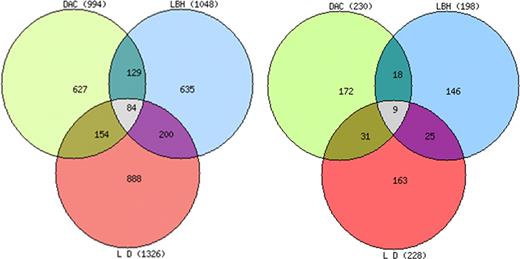Abstract
Abstract 435
Diffuse large B-cell lymphoma (DLBCL) is the most common type of lymphoid malignancy, representing approximately 30–40% of all lymphomas. While significant progress has been made in treating this disease over the past decade, it is still regarded as a heterogeneous disease which, after being classified as relapsed or refractory, is fatal in about one-third of patients. Histone deacetylase inhibitors (HDACI) are presently approved for the treatment of relapsed or refractory cutaneous T- cell lymphomas (CTCL), and have marked activity in peripheral T-cell lymphomas (PTCL), though their effectiveness in DLBCL is less established. DNA methyltransferases (DNMTs) are known to recruit and cooperate with histone deacetylases to induce gene silencing. Combinations of drugs affecting these pathways have emerged as active and important, mostly in myeloid leukemias. We hypothesized that the combination of HDACI and DNMT inhibitors (DNMTI) in DLBCL may be active only in combination and not as single agents. We examined the interaction between a broad range of HDACI including vorinostat, depsipeptide, panobinostat and DNMTI using in vivo and in vitro models of DLBCLs, clearly confirming that these agents are in fact synergistic with decitabine. Synergy was measured by relative risk ratio (RRR) and the values obtained were as low as 0.01, representing very strong synergy. This combination of drugs, specifically panobinostat and decitabine, was also shown to be strongly synergistic in a murine xenograft model of DLBCL. In addition, we analyzed the molecular basis for this synergistic effect by evaluating the global gene expression and methylation using microarrays on the cells treated with the single agents and combination in DLBCL. Three DLBCL lines (OCI-Ly1, OCI-Ly10 and Su-DHL6) were treated with decitabine alone (2.5 μ M), panobinostat alone (2.5 nM) or their combination for 48h hours. DNA and RNA from untreated and treated cells were used for genome wide methylation analysis through Illumina Humanmethyation27 platform and gene expression profiling analysis with Illumina HumanHT-12 v3 Expression arrays. 3D principal component analysis clearly clustered the samples treated with panobinostat and combination therapy together and at greater distances from untreated samples and samples treated by decitabine alone. Therefore, the contribution to the gene expression phenotype of the combination was greater from the HDACI than with DNMTI. Consistent with this observation, the top network of genes differentially expressed (p<0.05) by panobinostat involved critical transcription factors like GATA1, GATA4, SMAD and DNMT3A. Additionally, network-functional analysis of genes perturbed by the combination treatments enriched for critical pathways involved in cell death, cell development and cellular proliferation. Surprisingly, differentially expressed genes and networks identified by each of the treatment conditions and by combination therapy were unique with few overlapping genes as shown in Venn diagram in Figure 1a. Genome wide methylation analysis produced similar results with greater contribution to global methylation changes in cells treated by the combination therapy and decitabine as compared to HDACI. Again, methylation status of a distinct set of genes was altered by combination therapy as compared to the individual drugs (Figure 1b). Correlation between genome wide methylation analysis and gene expression profiling identified 16 overlapping genes in the samples treated by the combination of panobinostat and decitabine including known tumor suppressor genes like VHL, DIRAS3 and WT1. Taken together, integrative genomic analysis has provided insights into the relative contribution of independent epigenetic therapies to the combination phenotype. These findings may provide important leads in identifying unique biomarkers of response specific to the combination of panobinostat and decitabine in DLBCL.
Venn diagrams of the overlap in differentially expressed genes (p<0.05) between the three treatment groups: a) Panobinostat (LBH), Decitabine (DAC) and their combination (L D) affect the expression of distinct sets of genes in DLBCL cell lines; b) LBH, DAC and their combination affect the methylation status of distinct sets of genes in DLBCL cell lines.
Venn diagrams of the overlap in differentially expressed genes (p<0.05) between the three treatment groups: a) Panobinostat (LBH), Decitabine (DAC) and their combination (L D) affect the expression of distinct sets of genes in DLBCL cell lines; b) LBH, DAC and their combination affect the methylation status of distinct sets of genes in DLBCL cell lines.
O'Connor:Millennium Pharmaceuticals, Inc.: Membership on an entity's Board of Directors or advisory committees, Research Funding.
Author notes
Asterisk with author names denotes non-ASH members.


This feature is available to Subscribers Only
Sign In or Create an Account Close Modal